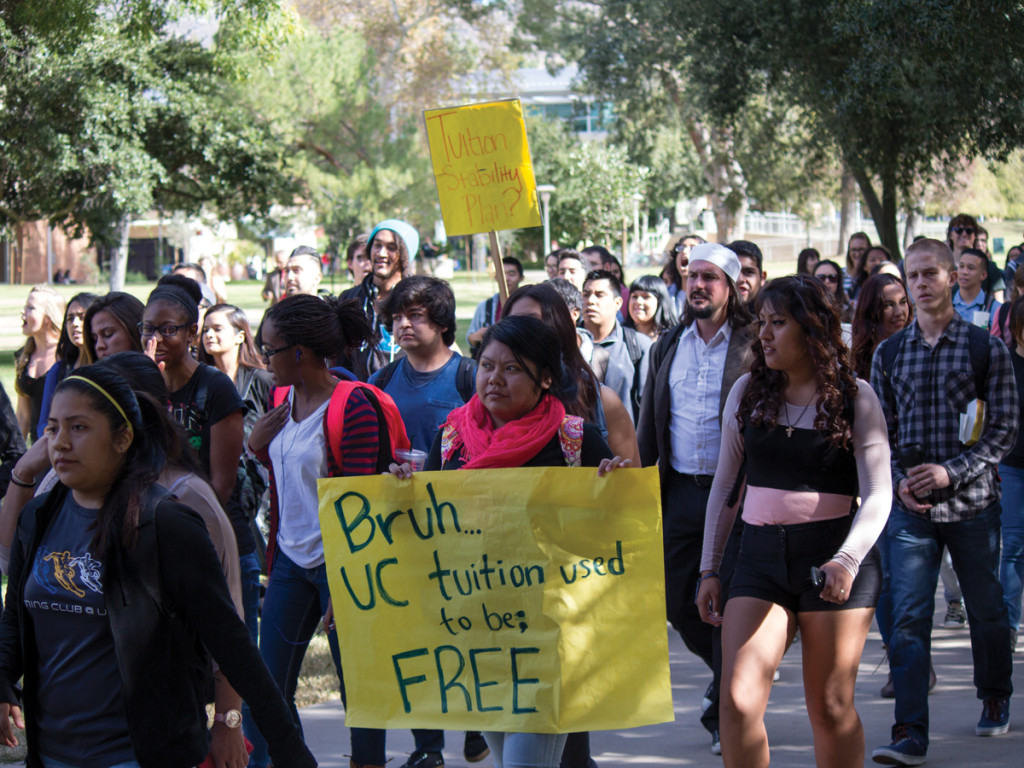
By now, almost everybody knows about the approval of UC President Janet Napolitano’s plan for up to a 5 percent increase of tuition annually until the 2019-2020 school year. In case it is unknown by anybody, this increase is a plan by Napolitano to motivate the California government to stop its continued disinvestment from the UC system by presenting them with increases proportionate to the amount of funding granted by the state. The plan takes effect if the state fails to raise funding up to the desired total of 7.3 percent, effectively acting as monetary backlash to the state’s failure to fund the UC; leaving California to either continue disinvestment, or place renewed financial support in the system, lifting the weight of higher education from students.
This plan is ill-conceived and ignorant to the fact that the ones threatened most by the potential tuition increases are not the governor and the state, but the students who will have to bear with the consequences of Napolitano and the UC regents’ power play.
Regents for the UC system have failed to realize — or simply don’t care to consider — that they are using students as pawns in a game of chicken with the state. At this point, the approved plan to keep the UC running can be boiled down to whichever organization flinches first: the state, buckling to the regents’ demands for investment and students’ rallying against paying more for the same education as those who paid less just a year prior, or the regents, realizing that the state holds most of the cards (financially speaking) and isn’t likely to give in, and again to the students, who are simply along for the ride. Either way the pendulum swings, students are left to cover the interim costs while the two sides argue over who has to ultimately foot the bill.
After three consecutive years of tuition freezes in the UC, it comes as shocking, and frankly appalling, that the best solution to the financial problems that the regents could come up with would be to slap students in the face with a “potential” — if not all but assured — raise in tuition. Though there are always extenuating circumstances and problems are rarely as simple to fix as they would appear, it is a poor showing to say that not only have finances not been fixed in regards to underfunded pensions, but that students will now be the sources of the wallets that regents will dig even deeper into. Gov. Jerry Brown’s 4 percent annual increase in funding to higher education clearly indicates that students won’t escape these increases, and can do little more than protest now that the plan has been passed.
Napolitano has repeatedly stated that this increase in tuition will hardly affect students of the system, unless their parents’ combined income is greater than $150,000 annually, as one-third of the money gained from the tuition increase will be funnelled into aid for students who would otherwise be unable to afford the costs of higher education. This assertion fails to take into account that when applying for government and school aid, the amount of money in savings and checking accounts are calculated in an effort to see how much parents are able to pay annually.
While those who have saved with their children’s college career in mind will be prepared for the reduced amount of aid the students will receive, parents who had other plans for these monies will be blindsided and those students may be left with no other choice than to take out loans to make up the difference. Assuming that students who enter college are usually in their mid- to late twenties, it’s no surprise to think that parents have saved money in an effort to support upcoming retirements, not thinking that their savings would negatively influence their child’s ability to receive aid. Additionally, with the current economy being somewhat volatile, any assumption that parental incomes will remain high after taxes have been filed and submitted for aid-approval is an assumption made in error.
Though the tuition raise may present a short-term solution to long-term issues of state funding, students shouldn’t be expected to pay up to $15,000 to attend public schools (prestigious though they may be). Students should continue to protest these hikes in their own ways, always keeping in mind that peaceful and organized rejection show that we, as a group, can be reasoned with. Additionally, before the first raise in tuition goes into effect, an actual dialogue — not a patronizing sentiment of “We are giving you what you need” — should be opened between the governor, UC President Napolitano, the regents, chancellors and students in order to work out a solution to the game of chicken between the state and the UC that doesn’t punish the students and their wallets.








